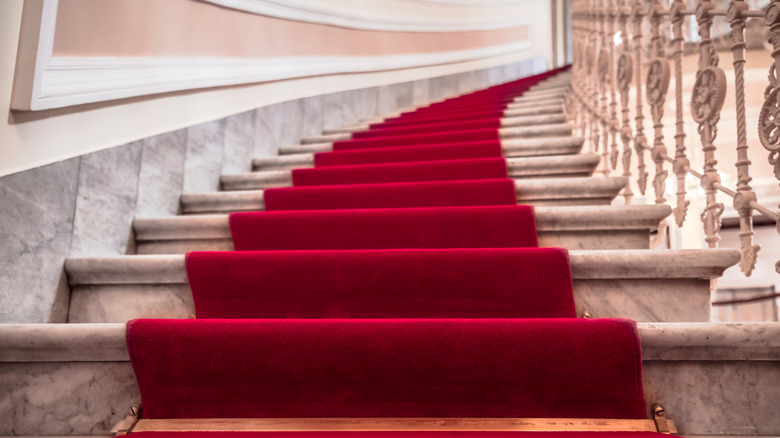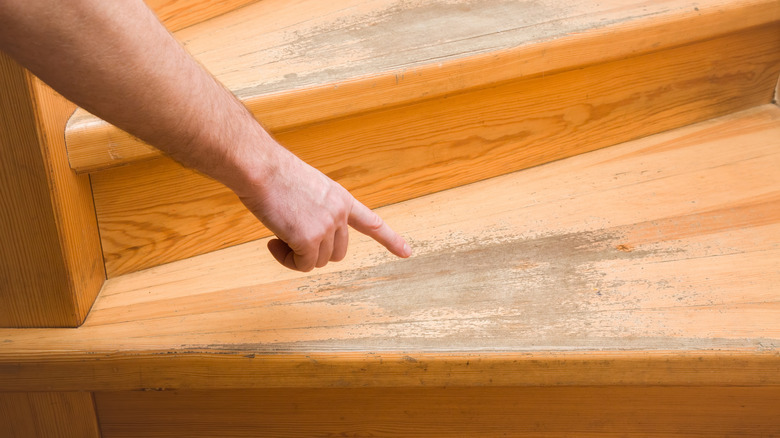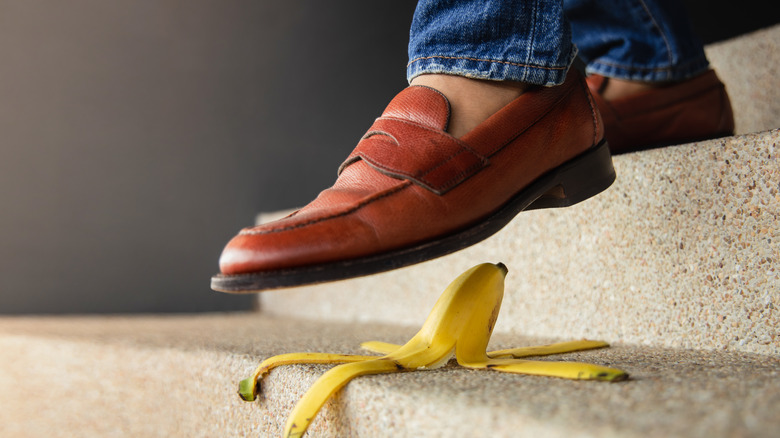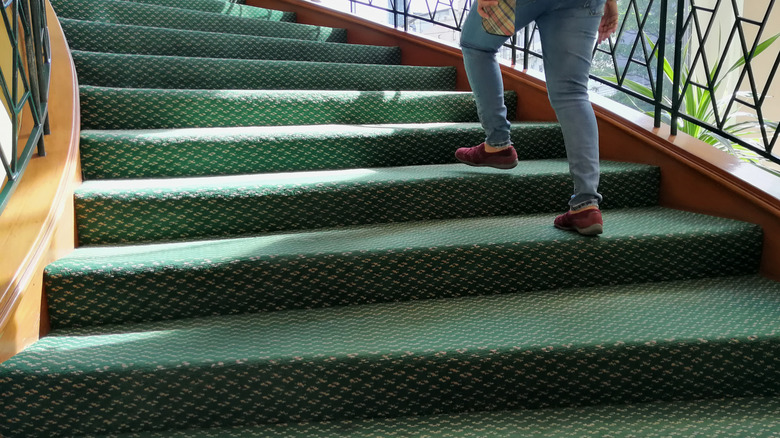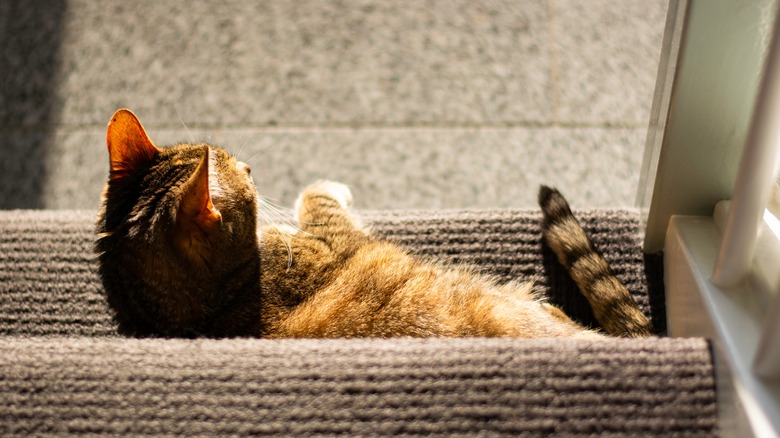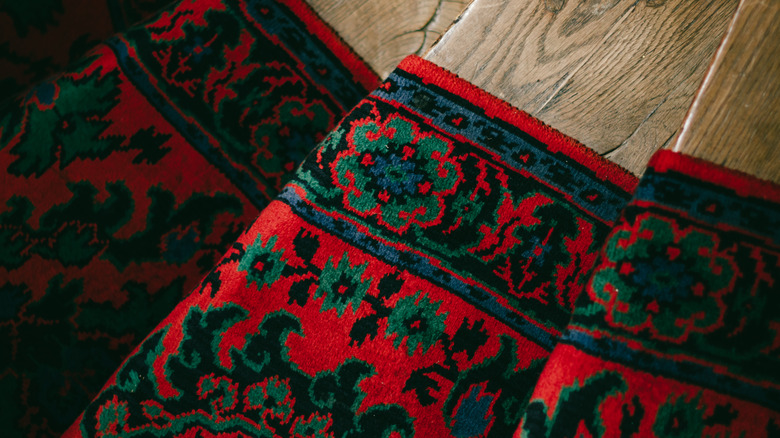5 Reasons Why You Should Add Carpet To Your Staircase
Moving into a new place, the big, showy centerpieces of the home get all of the attention. Who gets which bedroom? What's the kitchen situation? How well is the bathroom working? Where do we put the TV? When you imagine living in a new place, it's all of those places that you picture living your new life, and that's why it's easy to overlook a part of the house that actually has a lot more impact than you might think.
Staircases literally hold a home together, and as Weekend Builds pointed out, both wood- and carpet-finished stairs effectively get you and your family from lower to upper floors and back again. Of course, nobody thinks about all of the time they spend on the stairs, but they really are high-traffic areas, and making affordable upgrades to them can have an appreciable impact on your quality of life.
According to Direct Carpet, the stair surface spectrum runs the gamut from pure hardwood, which has a minimalist, clean aesthetic appeal, to a fully fitted carpet layer on both step and riser. In between these two all-or-nothing extremes is the carpet runner. This is a layer of carpet that covers the middle of the steps (and sometimes the middle of the riser), giving many of the benefits of carpeting but keeping the aesthetic appeal of the hardwood to the sides. So if you've never thought of adding a carpet layer to your staircase, here are five great reasons to do it.
1. Protection
If you already have hardwood floors as the surface of your staircase, you might not be particularly enthusiastic about covering up the beautiful grain. However, as Elegant Simplicity pointed out, a carpet stair runner doesn't cover the wood entirely and protects from the everyday wear and tear that they're subjected to due to their near-constant use.
According to Oak Valley Designs, the load-bearing nature of the staircase means that repairs can be expensive. Carpeting can protect the wood from boot marks, stains, claw marks, or scratches. This will reduce the required frequency of re-finishing the surface, saving you money.
This doesn't mean you should just buy some carpet and throw it onto your stairs. Amongst other reasons, if the carpet you select has a rubber backing, this could damage the underlying wood, according to Wood and Beyond. Rubber won't allow the wood to breathe properly and, as such, can cause a buildup of dampness or moisture, swelling, or even cracking on the surface of the stairs, so ensure you choose a carpet with no rubber backing.
2. Safety
According to Sofihas, stair falling injuries are second only to injuries involving a vehicle when it comes to insurance claims. The staircase is an area many people hurt themselves each year, and according to Senior Safety Advice, carpeted stairs are generally safer than plain wooden stairs for this reason — with a few caveats.
As explained by Interiors Place, carpeting stairs offers better traction, decreasing the chance of slipping. In addition, the extra layer of soft, padded material, although thin, does offer some cushioning to further reduce the risk of serious injury.
Having said that, it is important to mention that poorly kept carpets can actually become more slippery over time. If you let the carpet get old, the edge of the step will get worn down over time. According to Safety Step, constant wear on the small area around 1 inch from the front of the step can wear the carpet bare, making the surface tractionless and smooth, just at the point where people need the most traction to avoid falling. Therefore, regular maintenance is essential.
3. Noise reduction
High-traffic areas take a beating in terms of wear-and-tear, wherever they are in your home. However, most of them don't have built-in reverb. We tend to think of a squeak when thinking about stair noise, but listen to four teenage boys running up an uncovered wood staircase in boots, and it's not squeaking you'll hear, but loud, hammering bangs!
According to Expert Reviews, carpet is the practical answer when it comes to noise reduction. Wood, or other hard, shiny surfaces, reflect and amplify sound. Carpet, with its soft, fuzzy texture, is the kind of material that absorbs and dampens vibrations instead, per Soundproof Central. As a result, this option reduces the impact of feet on the stairs, so the disturbance produced is lower.
Noise reduction is one of those incremental, often unnoticed ways in which you can subtly improve the experience of living in your home. Why not use the excuse of safety, design, or comfort to give yourself the gift of not getting woken up in the middle of the night every time someone goes to the kitchen for a glass of milk, for example?
4. Comfort
There are two areas where carpets hold the advantage over bare stairs when it comes to comfort. Firstly, texture, and secondly, temperature. As Rivendell Carpets & Flooring mentions, carpet runners are softer underfoot and generally more comfortable than an uncovered staircase. However, a fully carpeted staircase comes with an underlay, absorbing noise and adding an extra layer of cushioning and comfort.
In terms of temperature, according to Physicsmax, a carpet is a bad heat conductor. When stepping onto a surface that's a good conductor, like wood or stone, all of the heat in your skin will be carried away, leaving you feeling cool. If the surface is a bad conductor (a carpet), the heat will stay in or on your foot. This is why stepping barefoot onto a cold wood staircase feels freezing, but the same foot on the same day stepping onto a cold carpeted staircase feels warm and comfortable.
5. Add style
If you want to make a visual statement with your stairs, for years, the assumption was that it would be done with plain wood. That's no longer the case, according to The Seattle Times: Now, design mavens are rediscovering the cozy comfort of carpet. Alongside design's embrace of greater comfort in the home, the rise of granny chic as an aesthetic has also meant more carpet throughout people's homes, and so more people are adding it to their staircases.
According to Foter, adding carpet to your stairs isn't just about sticking with one trend. Instead, they are called "fashion-forward" because a stair runner gives you so many more design options than sticking with plain wood or all carpet. Having both the carpet's materials, colors, and textures to choose from as well as the wood to the sides to tweak and personalize the look of your staircase, gives so much flexibility.
Fully carpeted stairs also give you a wide variety of choices for styling your staircase — however, for the best look and fit possible, you will likely need to pay a professional to install it properly. This isn't necessarily true for stair runners. According to Household Advice, you should expect to pay $3 to $15 per stair for the labor cost. Stair runners typically wouldn't need such sophisticated installation, so they are considered more budget-friendly.
